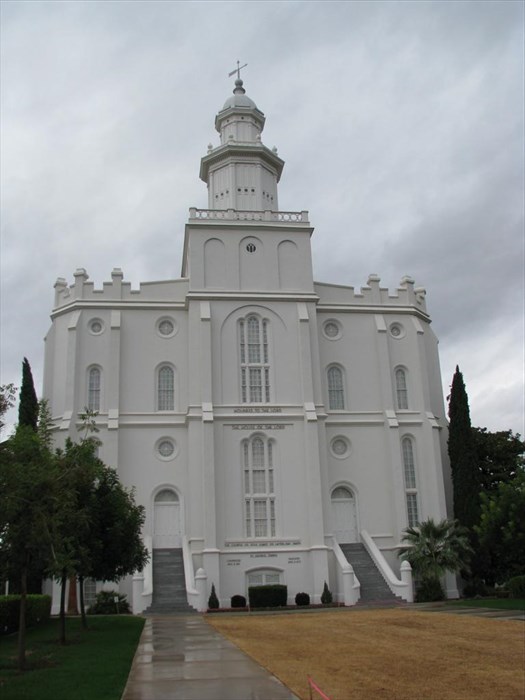"The St. George Utah Temple (formerly the St. George Temple) is the first
temple completed by The Church of Jesus Christ of Latter-day Saints after the
forced exodus from Nauvoo, Illinois, within two years of the death of Joseph
Smith, Jr. Located in the city of St. George, Utah, it was designed by Truman O.
Angell and is more similar in its design to the Nauvoo Temple than to later LDS
temples.
The St. George temple is the oldest temple still actively used by the members
of the Church. The temple currently has three ordinance rooms and 18 sealing
rooms, and a total floor area of 110,000 feet (34,000 m). It was originally
designed with two large assembly halls like the earlier Kirtland and Nauvoo
Temples. The lower Assembly Hall was partitioned with curtains to provide the
ordinance rooms for the Endowment Ceremony. In 1938 the lower Assembly Hall was
rebuilt with permanent walls dividing it into four ordinance rooms. The four
ordinance rooms were later changed into the present three rooms, at the time the
endowment ceremony was changed from a live endowment to one presented on film.
In the 1970s the temple was closed and underwent extensive remodeling.
Spencer W. Kimball rededicated it in 1975.
A temple for St. George was announced on November 9, 1871 by Brigham Young
and was dedicated on April 6, 1877. Even though the Salt Lake City Temple had
been announced years earlier in 1847, construction would continue until 1893.
The St. George Temple was built to satisfy the church's immediate need for an
appropriate place for temple ceremonies and ordinances. Because of the pressing
need, the building's groundbreaking ceremony was held on the day the temple was
announced. It was the third to be completed by the church and the first one in
Utah.
Brigham Young, President of the Church at the time, chose a six-acre plot as
the temple site. Unfortunately, the Saints soon discovered that the chosen site
was swampy with numerous underground streams. Young was consulted on moving the
site, but the prophet remained firm in the idea that this was the site for the
temple. To deal with the problem of the swampy site, the Saints created drains
to eliminate as much water as possible. Then they decided to bring lava rock to
the site, crush it and use the fragments to create a dry foundation for the
temple. This led to a new problem: how to crush the rock. Someone suggested
using an old cannon that the city had acquired. After creating a pulley system,
the cannon was used like a pile driver to compact the lava rock and earth and
create a firm foundation.
The old cannon had an interesting history. It was made in France and used by
Napoleon during his siege on Moscow. During Napoleon’s hasty retreat, however,
the cannon was left behind. It was later dragged to Siberia, then Alaska, and
finally ended up at a fort in California. Members of the Mormon Battalion
acquired the cannon, had it mounted on wheels, and brought it to Utah. Today,
the old cannon is displayed on the temple grounds.
After stabilizing the foundation, work finally began on the structure itself.
The walls of the temple were constructed out of the red sandstone common to the
area and then carefully plastered for a white finish. The Saints worked
tirelessly for over five and a half years to complete the temple. Historians
James Allen and Glen Leonard made note of the dedication shown by the pioneers
in Southern Utah. The workers opened new rock quarries, cut, hauled and planed
timber, and donated one day in ten as tithing labor. Some members donated half
their wages to the temple, while others gave food, clothing and other goods to
aid those who were working full time on the building. Mormon women decorated the
hallways with handmade rag carpets and produced fringe for the altars and
pulpits from Utah-produced silk. At its completion, it contained a million feet
of lumber, which had been hand chopped and hauled between forty and eighty
miles. They also used seventeen thousand tons of volcanic rock and sandstone,
hand cut and hauled by mule teams.
In honor of the temple, the Church's general conference was held in the House
of the Lord at St. George. The temple dedication ceremony took place on April 6,
1877. Young presided and Daniel H. Wells, his second counselor, gave the
dedicatory prayer. The St. George Temple was the only temple completed while
Brigham Young was president. Shortly after the dedication and the conference,
Young returned to Salt Lake and died a few days later on August 29, 1877 at age
76 years.
When the temple was completed, Young was not completely satisfied with the
tower and dome; in his words, it was too "squatty." He suggested having it
fixed, but the Saints were so excited to have the temple operational that Young
did not push the suggestion. About a year after the dedication, on October 16,
1878, a large storm rolled through St. George and a lightning bolt struck the
tower of the temple. Extensive damage made it necessary to reconstruct both the
tower and dome. Young's feelings were well known and when a design was created,
the tower was taller. This led the builders to claim that, even in death,
Brigham Young got his way." -
Wikipedia